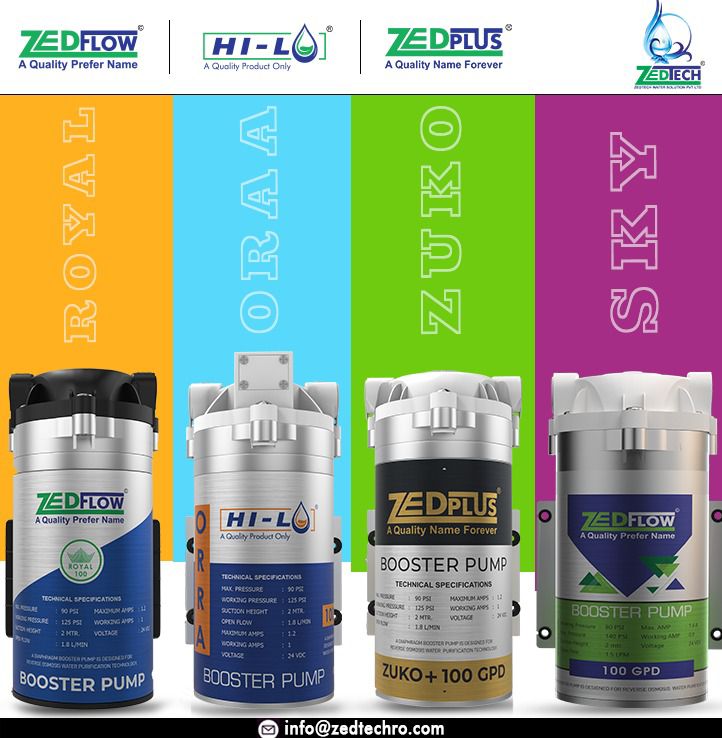🔧 What is a 100 GPD RO Booster Pump?
A 100 GPD (Gallons Per Day) RO booster pump is a compact, high-pressure water pump designed to increase the input water pressure in reverse osmosis (RO) water purifiers. It is ideal for domestic RO systems that purify up to 100 gallons (about 375 liters) per day.
📐 Specifications (Typical Range)
| Feature | Value / Description |
|---|---|
| Flow Capacity | Up to 100 GPD (≈375 LPD) |
| Working Pressure | 80 – 100 PSI |
| Max Pressure | 120 PSI (some models up to 140 PSI) |
| Self-Suction Height | Up to 2 meters |
| Power Supply | 24 Volts DC |
| Current Draw | 1.5A – 2.5A |
| Fittings | 1/4 inch (6mm) push-fit elbows |
| Motor Type | DC diaphragm pump |
| Winding Type | Copper / Aluminium / Copper-coated aluminium |
| Size (approx.) | 18 x 9 x 9.5 cm |
| Noise Level | Low (varies by quality) |
⚙️ Working Principle
A 100 GPD booster pump works using a DC motor with a diaphragm pump mechanism. It increases the inlet water pressure, ensuring that the RO membrane gets sufficient force to remove TDS, salts, and other impurities.
Without sufficient pressure (ideally 50–70 PSI minimum), RO membranes don’t work efficiently, leading to:
- More water wastage
- Low output water
- Poor TDS reduction
✅ Key Features & Benefits
- Boosts RO Performance
- Increases water pressure for low-pressure water supply zones.
- Essential for areas where inlet pressure is below 40 PSI.
- Improves TDS Reduction
- Ensures effective removal of salts, fluoride, arsenic, and other dissolved solids.
- Extends Membrane Life
- Maintains optimum flow through the membrane, preventing fouling.
- Saves Water
- With good pressure, RO systems waste less water during the filtration process.
- Copper Winding Pumps (Recommended)
- Provide better durability and efficiency compared to aluminum-wound pumps.
- Preferred in areas with hard water (high TDS).
🔌 Power Compatibility
- Operates on 24V DC SMPS power supply (2 to 2.5 amps).
- Ensure you use a good-quality RO SMPS Adapter, ideally with a 2-year warranty and over-current protection.
🔧 Installation & Usage Tips
- Mount it vertically with inlet at bottom, outlet at top.
- Use with auto-cut switch to avoid dry running.
- Always pair with a pressure switch and a float switch if connected to a storage tank.
- Ensure no air leakage from fittings and tubing.
- Clean sediment prefilters regularly to protect the pump.
🛠️ Maintenance Tips
- Clean filters every 3–6 months to reduce load on the pump.
- Check for leakage or low pressure after ~1 year.
- Replace the pump if:
- There’s continuous loud noise.
- Output drops significantly even with new filters.
- The motor heats up excessively.
❗Common Issues & Troubleshooting
| Issue | Cause | Solution |
|---|---|---|
| Low flow | Clogged membrane or filters | Replace filters/membrane |
| No power | Faulty SMPS | Check with multimeter, replace |
| Noisy pump | Air lock or worn diaphragm | Bleed air, or replace diaphragm |
| Overheating | Overvoltage or dry run | Check voltage, use float switch |
